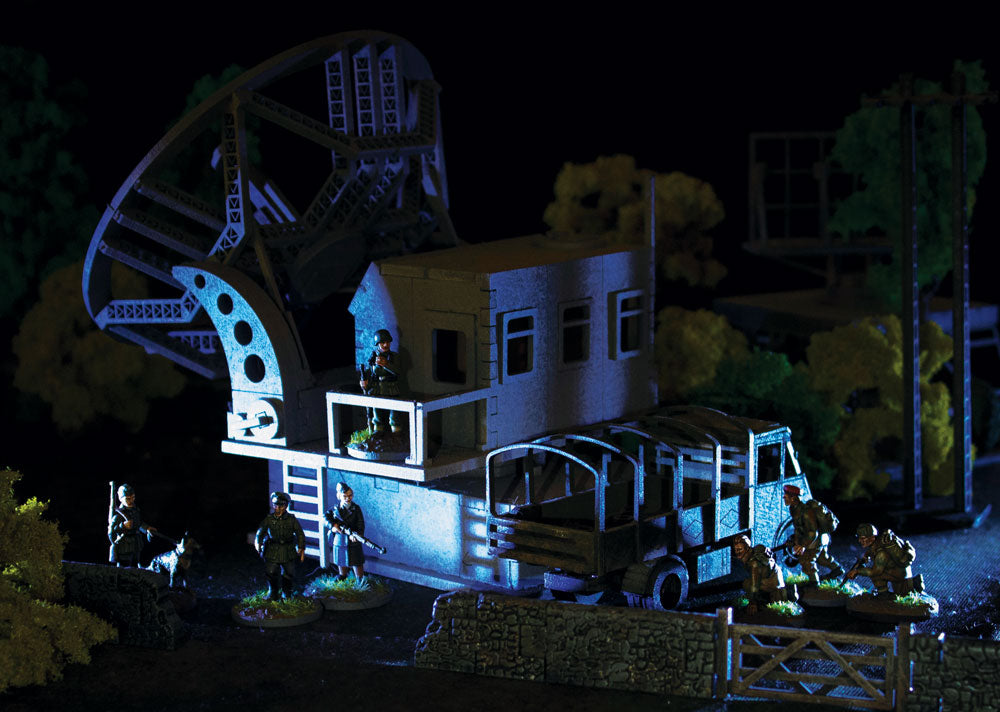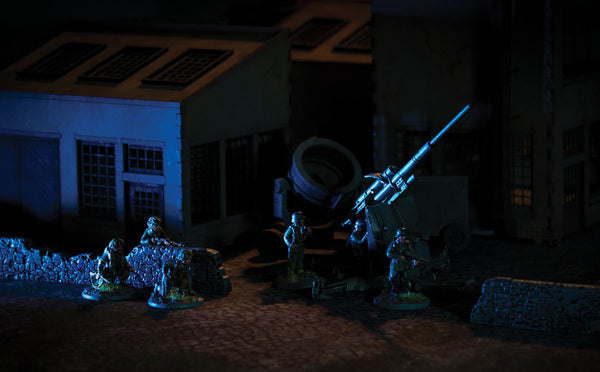
02 Hundred Hours Designer's Notes

I have always liked games that generate an exciting story, a narrative of events that takes you beyond a test of manoeuvre and dice-rolling. When I play a wargame, I want to feel like I’m living out the finale of a classic action movie, with distinct characters, heroes and villains, moments of heroism and sacrifice, high tension and bad fortune all playing their part.
For 02 Hundred Hours, my focus was night-time commando raids in World War II. There is a rich pool of inspiration, both historical and fictional – films like Where Eagles Dare and The Guns of Navarone, as well as the many incredible real-world operations that took place…
After the disaster of the German Blitzkrieg and the retreat to Dunkirk, Churchill ordered the creation of a new type of fighting force, based on the ‘butcher-and-bolt’ tactics of the irregular soldiers he had encountered during the Boer War, 40 years earlier. Such ungentlemanly behaviour was actively opposed by the military establishment, but their success led to the aggressive ‘commandos’ being replicated in various forms by every nation in the war.
Small groups of the SAS infiltrated the enemy lines, assisted by spies from the Special Operations Executive as well as local resistance fighters. Under cover of darkness they launched attacks on radar stations, airfields and rail lines, sneaking past sentries, taking them out with silent take-downs or opening fire in deadly ambushes. They would plant charges, grab intelligence or even kidnap enemy officers and then fight clear before reinforcements could arrive.
These were the events I wanted to recreate on the tabletop, and that required rules for something that is not often tackled in wargames – stealth.

Hidden in the Dark
Of course, in any wargame the players have a god-like view of everything on the table (and generally don’t play in the pitch black!). As such, the ‘fog of war’ – the fact that your toy soldiers wouldn’t actually know where enemies are – is either ignored completely or, as in my case, had to be simulated by the game rules.
In 02 Hundred Hours, the first step to achieve this is that at the start of a game, none of the fighters on either side know where their enemies are. This is referred to as being ‘covert’. If a combatant is spotted or gives themselves away somehow, they become ‘detected’, allowing the enemy to move towards them and potentially attack.
Noisy Dice
My initial idea was for one dice-face to represent alerting the enemy, so the more dice you roll, the more likely you are to be seen or make a noise. This quickly evolved into two types of dice, one white, representing noisy actions with the chance being detected, and the other grey, for quiet, stealthy behaviour with the chance of cancelling out an ‘Alert’ from the noisy dice, and allowing detected soldiers to become covert again, slipping away into the shadows.
In fact, many actions use a combination of both dice. A Sneak action might use two of the ‘quiet’ dice and one of the ‘noisy’ dice, so you’re likely to stay hidden but there’s always a small possibility of things going wrong! On the other hand, firing a Tommy gun uses three of the noisy dice, so it’s likely (but not guaranteed) that the enemy will spot your position.

Patrolling Sentries
I’ve played plenty of games in which darkness is represented by a ‘spotting roll’ to randomize how far a model can ‘see’ before shooting. However, you rarely see any restrictions on how models move around, which makes it impossible to do anything particularly secretive. If you try to sneak a unit behind enemy lines, your opponent can simply move troops to counter the threat, even though the men on the ground would have no idea it was coming.
So for 02 Hundred Hours I needed some limitations on the way models move about. Firstly, the lowly sentries move along a patrol route that the defending player marks out at the beginning of the game. Other defenders make a Roving Patrol move, which heads in a random direction pointed by the chevrons on the dice. A good roll allows the player to choose which direction to follow. However if there is a detected enemy close by, the defenders make a faster move directly towards that enemy. This often leads to spotting more foes and raising the alarm, but also pulls the sentries out of position and may leave holes for the attackers to exploit.
The attackers have a little more leeway, sneaking slowly in any direction, but can only move fast towards a detected enemy.
Raise the Alarm!
For a realistic behind-the-lines raid, the game starts with the defenders unaware they are under attack and they won’t open fire straight away. No point waking up the whole garrison if that thing rustling in the bushes is just a stray dog, right? Only once a certain number of enemies are detected is the alarm raised, and the defenders are free to shoot and fight. Naturally things like gunfire, explosions, finding a body or coming face-to-face with a foe set off the alarm much faster.
Even once the alarm has gone off, defenders who are too distant from a detected enemy must use the semi-random Roving Patrol to move around – not always in a useful direction. Players may find it jarring that they don’t have full control over where their models go, but keep in mind that the soldiers on guard duty in the rear echelon were not generally front-line veterans. More often they were inferior, older conscripts, and in many cases they were men from occupied countries, coerced into the ranks by threats to their families. Such troops could certainly not be relied upon to run towards gunfire or behave exactly how a commander might wish, but you do at least get a lot of them!
The result is that even in the final stages of the game, with the alarm raised and a firefight raging, there is still scope for covert fighters to sneak around and get the drop on an unsuspecting foe or make a final dash for an objective.

Turn to Face
The final piece of the puzzle was to give each miniature a facing, with a front and back (the dividing line goes through the shoulders). Fighters can only see to the front, which creates entertaining possibilities for attackers to nip behind sentries once they have passed along their patrol route. This is balanced by the chance of that sentry turning to look at just the wrong moment!
In addition there are crucial bonus dice when attacking from the rear (as well as for being covert), turning melee attacks with a Fairbairn-Sykes combat knife from a noisy brawl into a silent cut across the throat.
Open Fire!
I won’t go into much detail about the workings of combat. They are fast, intuitive and easy to learn so that after a single game you’ll have them down pat and be able to concentrate on tactics. Although the dice mechanics are very different, the overall sequence will be familiar to anyone who has played Test of Honour.
Soldiers that survive an attack may suffer ‘trauma’, representing minor wounds as well as suppression or pinning. This makes them lose an action and repeated trauma can take them out of the game altogether.
Telling the Story
As an extra layer of detail there are also several types of cards, drawn as the game progresses, that introduce all sorts of heroics, unique skills and unexpected occurrences.
The attackers have Order cards, allowing them to take two actions in a row with the same soldier (such as a sneak move and then attacking), or for two soldiers to act together (such as one spotting an enemy and the other shooting).
Meanwhile, the defending player gets Event cards. These reflect more unusual defensive efforts such as radio intercepts, searchlights or changing the patrol route, as well as random, unfortunate occurrences and mishaps that could befall the attackers such as bright moonlight, low ammo or even a sudden sneeze! For the purposes of the game, the defender gets to decide precisely when these things happen, hoping to mess up their opponent’s game-plan at crucial moments.
Finally, both sides have Veteran cards that allow you to personalise specific troops with improved abilities such as being an expert scout or extra kit like smoke grenades or a hip flask of whiskey. If you are playing a series of battles in a campaign, Veteran cards can be kept, so your force becomes more experienced over time.
Choosing Your Force
There are no army lists restricting which models you can use. If you want you could have an attacking force with a mix of British, Americans, French, maybe even a German defector. You can choose to stick to historical references or emulate the assorted cast of those classic movies!
The defenders can select from Heer sentries, Feldgendarmes (military police) and guard dog handlers, plus characters including officers, sinister Gestapo or an unscrupulous scientist! And of course you could switch in Italian or Japanese troops depending on the theatre.
The opportunity is there to write your own incredible war stories.

Something New
02 Hundred Hours is without doubt an extremely characterful, entertaining skirmish game. And I think it breaks new ground by taking us beyond the standard wargaming mechanics of ‘move, shoot, fight’. It adds the element of having to discover the enemy, not as an afterthought but baked right into the core of the game, so you now have ‘move, spot, shoot, fight’. The result is a very different gaming experience!
Future Plans
The plan going forward is to introduce more forces and countries in the same manner – French partisans, Americans, Italians, etc. There may be rules for different environments, such as the deserts of North Africa or the jungles of Asia, both distinct settings that saw many raiding missions during the war. Jungle is particularly interesting as dense foliage has the same effect as darkness in terms of cutting down line of sight and weapon ranges.
In addition, there have been a lot of requests for a fully solo version. It wouldn’t require too much adjustment to come up with an AI system for the defending sentries, so this is high up on my list.
And I’m also thinking about the possibility of a ‘versus’ mode that uses the night-fighting and alert system for a head to head battle. This would allow players to bring the game’s sneaky approach to a more competitive environment, fighting out the result when two patrols bump into each other in the darkness!
